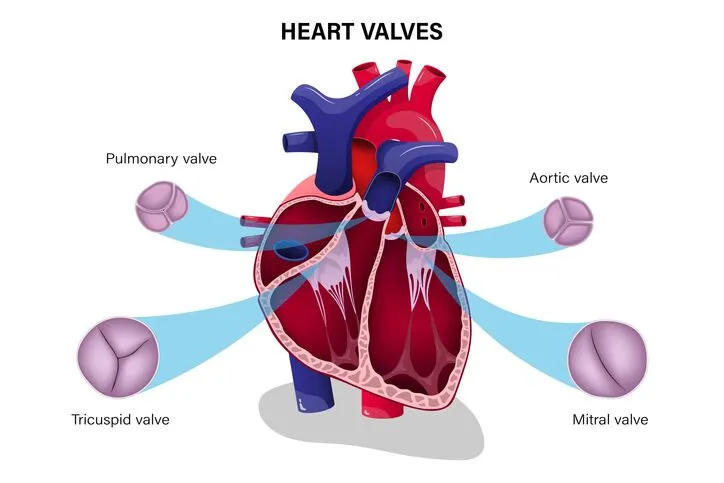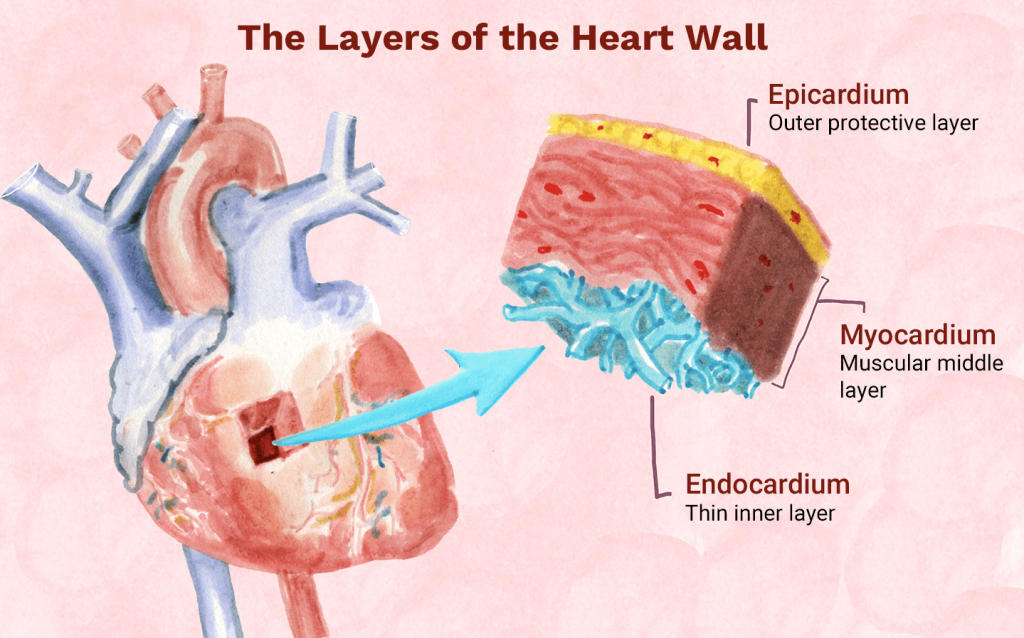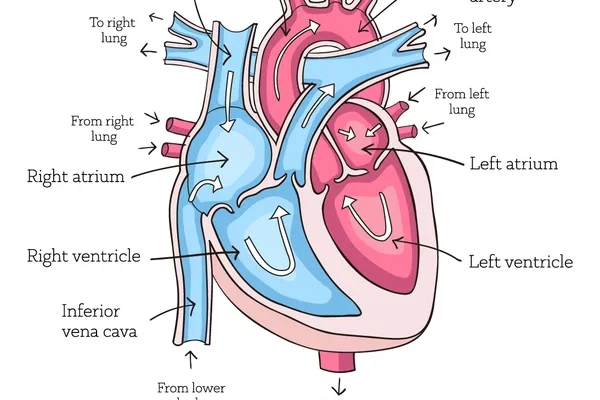The human heart is an incredible organ that plays a fundamental role in our survival. Imagine a small, muscular pump that tirelessly works day and night, keeping us alive by circulating blood throughout our bodies. For many students, the heart can seem complex, but let’s break it down into simpler terms to understand its magic.
What is the Human Heart?
The Human Heart is a fascinating and essential organ in our body, acting like a powerful pump that keeps us alive and well. It’s about the size of our clenched fist, and even though it might seem small, it has a huge responsibility.
Imagine a busy delivery system, like the post office or a courier service. The heart functions similarly, delivering necessary items to various parts of our body to keep everything running smoothly. But instead of parcels and letters, the heart sends blood, which carries vital ingredients such as oxygen, hormones, and nutrients like glucose. This blood travels through a network of roads, known as blood vessels, reaching each cell in our body, ensuring they have what they need to work correctly.
Oxygen is like the breath of life for our cells, hormones act like messengers giving instructions, and glucose provides the energy our cells need to perform their tasks. Every part of our body, from our brain to our toes, relies on the essential elements that the heart pumps through our blood.
Remember, the heart is muscular and robust, tirelessly working, beating, and pumping, symbolising a wonderful combination of strength and consistency in our bodies. It lays the foundation for understanding its extraordinary features and functions, which we will explore further in the subsequent sections, beginning with its location in the next part.
Where is the Heart Located?

Having learned about the essential role the heart plays, let’s delve into its specific location in our body. Picture your chest as a protective house, and inside this house, the heart has its special room, nestled right between our lungs.
If you gently place your hand on the centre of your chest and then slide it a little to the left, you’re essentially feeling the area where your heart resides. It’s not entirely on the left side, but it tilts slightly in that direction, resting just to the left of the breastbone, also known as the sternum. This positioning ensures the heart remains protected while it does its essential work.
This special room where our heart lives is termed the ‘thoracic cavity.‘ Think of it as a safety chamber, providing an additional layer of protection for the heart against any external harm.
Delving a bit into its origins, our heart’s development is truly a wonder. During our earliest stages as an embryo, specialised cells from the ‘mesodermal germ layer‘ come together, signalling the beginnings of our heart. This scientific term might sound complicated, but in simpler words, it refers to one of the primary layers from which various organs and tissues in our body originate.
Now that we’ve located the heart and glimpsed its beginnings, let’s proceed to understand its significance in the subsequent section, titled, “Why is the Heart Important?”
Why is the Heart Important?
Having journeyed through where the heart is located, let’s unravel the mysteries of why the heart holds such prime importance in our bodies. Our heart isn’t just an organ; it’s like a powerful engine that keeps our body running smoothly. Here are some of its critical roles explained-
1. Pumps Blood-
The heart’s fundamental job is akin to a diligent pump. Imagine it as a superhero, tirelessly working to ensure that blood travels to every nook and cranny of our body. This constant circulation of blood is essential because it helps transport vital nutrients and energy that our body parts need to function optimally.
2. Delivers Oxygen-
The heart plays the role of a fabulous delivery system. It ensures that oxygen, which we inhale from the air, is carried by the blood from our lungs to all other parts of our body. Oxygen is like a special fuel that helps keep all our body’s cells alive and functioning.
3. Regulates Pressure-
Maintaining balance is key in many aspects of life, and the heart masters this in the realm of blood pressure. The heart ensures that the pressure of the blood flowing through our vessels is neither too high nor too low. By doing this, it helps keep a stable environment, ensuring that our body parts receive blood in just the right amount to work correctly.
Understanding the significance of our heart’s roles guides us deeper into its operational mysteries. Moving forward, let’s delve into how the heart performs these extraordinary tasks in the next section, titled, “How Does the Heart Work?”
Also Check – 13 Important Functions of Heart
How Does the Heart Work?
Having grasped the pivotal role our heart plays, let’s journey into the inner workings of this remarkable organ. Think of the heart as a bustling city with its intricate network of roads, ensuring that everything moves efficiently from one point to another. This “road system” of the heart is known as the circulatory system, and it comprises three main routes-
How Does the Heart Work?
How Does the Heart Work?
- Starting Point: The Heart
- Description: The heart is ready to receive and pump blood throughout the body.
- Pulmonary Circulation
- Receive deoxygenated blood
- Description: The heart receives deoxygenated blood from the body.
- Pump to Lungs
- Description: The heart pumps the blood to the lungs to get oxygen.
- Return Oxygenated blood
- Description: Oxygen-rich blood returns to the heart from the lungs.
- Receive deoxygenated blood
- Systemic Circulation
- Pump Oxygenated Blood
- Description: The heart pumps oxygen-rich blood to the entire body.
- Return Deoxygenated Blood
- Description: After delivering oxygen, the blood returns to the heart, lacking oxygen.
- Pump Oxygenated Blood
- Coronary Circulation
- Oxygen to the Heart
- Description: The heart’s muscle gets the oxygen it needs.
- Oxygen to the Heart
- Back to Starting Point
- Description: The cycle repeats, ensuring continuous circulation of blood.
1. Pulmonary Circulation-
In this loop, the heart acts like a shuttle service. It picks up blood that’s low in oxygen and sends it on a quick trip to the lungs. Why? To collect fresh oxygen, of course! Once the blood is enriched with oxygen, the heart ensures it’s brought back, ready to be dispatched to various parts of our body.
2. Systemic Circulation-
This is where the magic happens! Once our blood is loaded with oxygen, the heart takes on the role of a distributor. It pumps this oxygen-rich blood out to every single cell in our body, from the tips of our fingers to our toes. This oxygen acts as a fuel, giving cells the energy they need to function and keeping us alive and active.
3. Coronary Circulation-
Don’t forget; the heart is a muscle, and like every other muscle, it needs its share of oxygen to function efficiently. In this unique circulation route, the heart ensures it nourishes itself. It sends blood through vessels that run along its surface, allowing the heart muscle to absorb the oxygen it requires to keep beating relentlessly.
With this foundational understanding of how our heart operates, we can now dive deeper into its internal architecture in the upcoming section titled, “The Structure of the Heart.”
Also Check – How Blood Flow in Heart ?
What Keeps the Blood Flowing in One Direction?
Ensuring that the heart’s blood flow follows a specific route, much like a traffic director, is a set of vital structures called the valves. Picture them as specialised doors within our heart-house. Their main job? To maintain order and direction in the flow of blood.
Understanding the Valves-

- 1. Tricuspid Valve- Situated between the Right Atrium (the upper reception room) and the Right Ventricle (the lower action-packed room), the Tricuspid Valve has three flaps. It ensures that when the heart pumps, the blood flows only from the atrium to the ventricle, not the other way around.
- 2. Mitral Valve (or Bicuspid Valve)- Found between the Left Atrium and the Left Ventricle, the Mitral Valve comes with two flaps. Like its counterpart on the right, it also ensures one-way traffic- from the atrium to the ventricle.
- 3. Pulmonary Valve- Positioned at the exit of the Right Ventricle, this valve channels blood towards our lungs. When the ventricle contracts, this valve swings open, allowing blood to rush to the lungs to pick up oxygen.
- 4. Aortic Valve- Located at the Left Ventricle’s exit, this valve is a gateway for oxygen-rich blood to reach our body. Every time the heart beats, it permits blood to flow from the heart into the aorta (our main artery) and onwards to nourish every part of our body.
Each valve operates like a one-way door, opening to let blood through and then snapping shut to prevent any backward movement. Through the meticulous work of these valves, our heart maintains a rhythmic and unidirectional flow of blood, making sure every corner of our body receives the nourishment it requires.
Also Check – Heart Valves- Types, Location, Structure and Functions
Ready to dive deeper? Let’s peel back the layers of the heart in the next section, “A Closer Look at the Heart’s Layers.”
A Closer Look at the Heart’s Layers

Just as we wear multiple layers of clothing to protect ourselves from the elements, our heart also has multiple layers. Each layer plays a crucial role in ensuring that our heart functions effectively and remains safe. Let’s peel back these layers and delve deeper into their unique roles.
1. Pericardium- The Heart’s Protective Shield
Think of the Pericardium as a tough, protective bag enveloping the heart. This outermost layer safeguards the heart against infections and ensures it remains in its dedicated spot within our chest. By keeping the heart from moving around too much, the Pericardium helps it to beat efficiently and without interruption.
2. Epicardium- The Smooth Operator
Right beneath the Pericardium lies the Epicardium. This layer might seem thin, but it’s essential. Acting as the heart’s lubrication system, the Epicardium secretes a fluid that minimises friction between the heart’s moving parts. Imagine it as the oil in a machine, ensuring everything runs smoothly.
3. Myocardium- The Heart’s Powerhouse
The bulk of the heart’s muscle tissue is found in the Myocardium, making it the thickest layer. Every time our heart beats, it’s the Myocardium’s muscle fibres contracting that powers this vital function. This layer is what enables our heart to pump blood vigorously, ensuring it reaches every nook and cranny of our body.
4. Endocardium- The Delicate Inner Lining
Last, but certainly not least, is the Endocardium. This smooth, innermost layer lines the heart’s chambers and valves. Its primary role? To provide a silky pathway for blood to flow without interruption. Moreover, it also ensures blood doesn’t stick and form clots within the heart.
By understanding these layers, we get an intimate glimpse into how meticulously our heart is constructed. Each layer, working in harmony with the others, ensures our heart remains a well-oiled, efficient pump.
Comparative Overview- The Human Heart Vs. Animal Hearts
While our guide primarily focuses on the anatomy and function of the human heart, it’s interesting to note that the hearts of different animals can vary significantly from ours. Here’s a brief glimpse-
- Fish- Fish have a simple two-chambered heart. It consists of one atrium to receive blood and one ventricle to pump it out, mainly sending the blood to the gills to pick up oxygen.
- Amphibians- Most amphibians, like frogs, have a three-chambered heart with two atria and one ventricle. This structure is a bit more complex than fish but still not as separated as mammal hearts.
- Reptiles- Reptiles, like turtles and snakes, generally have a three-chambered heart too. However, some reptiles, like crocodiles, have a heart that is almost four-chambered, much closer to the structure of bird and mammal hearts.
Comparing the human heart to those of different animals gives us a perspective on the evolutionary journey of this vital organ. But for this guide, we’ve kept our primary focus on understanding the human heart’s intricate design and essential role in our bodies.
Interesting Facts about the Heart
- The heart pumps around 6,000-7,500 litres of blood every day.
- It beats about 100,000 times a day – that’s 3 billion beats in a lifetime!
- An average adult’s heart beats 60 to 100 times per minute, while a newborn’s heart beats faster, around 90 to 190 times per minute.

